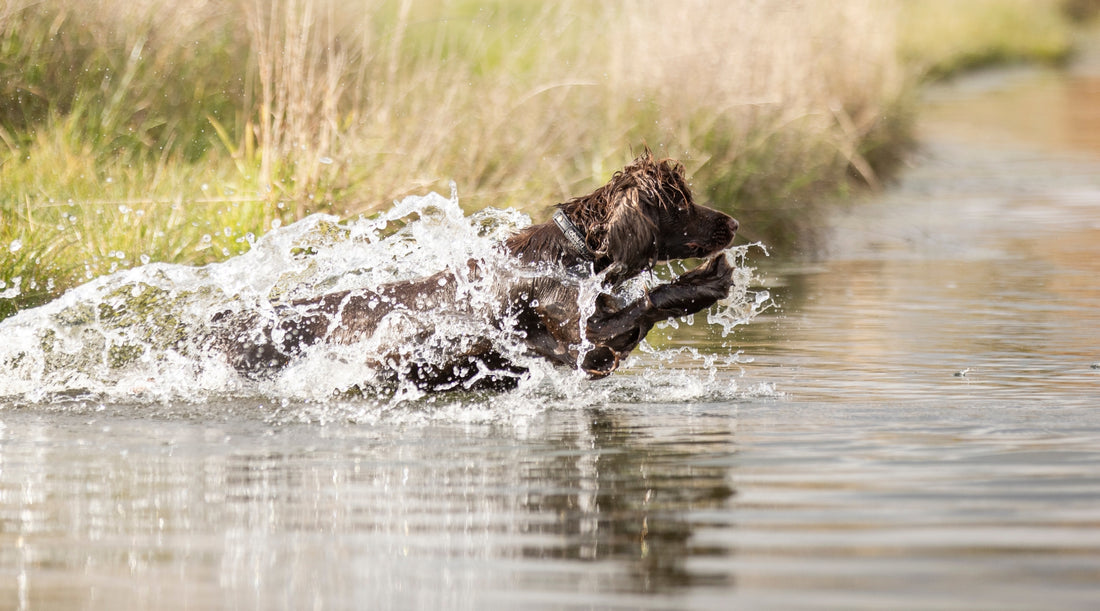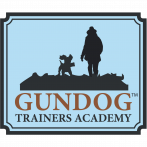
Seven ways to capture professional-looking photographs of your gundog
Share
Our gundogs hold a special place in our hearts. No matter how frustrating training can be at times, we love them unconditionally and cherish the time spent with them out in the field.
Puppy training classes, gundog group sessions, family dog walks, days out beating, picking up, and competing in working tests and trials - our gundogs provide us with a very long list of memorable moments during their relatively short time with us.
For pet and working gundog owners alike, capturing the essence of your gundog in training or out on a shoot is a way to celebrate the hard work that you have both put in as a team and the special bond you share.
High-quality photographs allow us to relive the countless moments we spend with our dogs and share them with others.
Your phone's camera roll is already likely to contain more pictures of your beloved gundog than of your significant other. And we don’t want to discourage that!
In this month’s blog, we have teamed up with professional photographer Alice Loder to provide you with some top tips to help you capture professional-looking photographs of your gundog, ensuring that each image does justice to these incredible animals, even if you only have access to the camera on your smartphone.

Get down to the dog's level.
One of the simplest yet most impactful techniques in gundog photography is getting down to your dog's level. This approach can instantly transform your photos from average snapshots to professional-quality portraits, even with a smartphone camera.
When you get down to your gundog's eye level, you see the world from their point of view. By kneeling, crouching, or even lying on the floor, you will create a more intimate connection between the viewer and the dog, making the photograph more engaging and personal.
It also draws attention to the gundog's face and expressions, capturing their personality and emotions more effectively.
This doesn’t mean you need to take all your pictures like this. Be intentional and brave with your angles. If you want to capture a cute, characterful image looking down on your dog, then stay above them and keep your phone horizontal. This will make the dog's head and eyes the most prominent feature and can be great fun, creating a 3D immersive effect, especially when the dog sits in long grass, a flower meadow, or ferns.

Avoid direct sunlight.
It is a common misunderstanding that the more light you have, the better when it comes to photographing your gundog.
Bright, direct sunlight can create harsh shadows and overly contrasty images, which are not flattering for any subject, including our gundogs. If your dog is a lighter colour, you will also lose a lot of detail.
Something else to consider is that during summer, those cloudless, bright, sunny days tend to be quite warm, and we want to avoid taking pictures of our dogs looking too hot and uncomfortable.
Overcast days and sitting in the shade of a tree are the best ways to get soft and even light. If you have a black dog, you will find that cloudy sunshine will be the best condition for your photographs.
Positioning yourself and the dog so that the sun is behind them will create a bokeh and a lovely dreamy background, especially if the sun is shining through the canopy of a tree or some ferns.
If you can choose when to take your photographs, early morning or late afternoon, known as the golden hours, provide warm, soft light that enhances the natural beauty of your gundog and the environment.

Frame your shots properly.
Unless you are cropping for an artistic effect, such as a head-and-shoulders portrait style image, capturing the entire body of your gundog in a photograph is crucial.
While it is absolutely something we have all done, nothing looks more amateurish than cutting off the dog’s feet, tail, or tips of its ears. This makes the photograph feel incomplete and awkward.
Proper framing of your shots to include the entire dog and some sense of location, space and context, will quickly result in a more polished and professional end photograph that has depth and tells a story.
If you are struggling to fit your whole dog in the frame, try taking a few steps backwards. Always check the edges before you take the photo, and consider taking the same picture from different angles.
Remember that photography is all about being creative. Try not to get stuck taking your photos from the same position - don’t be afraid to play around with angles that “break the rules”.

Focus on the eyes.
The eyes are the window to the soul, which also holds true in dog photography. Ensuring the eyes of your gundog are in sharp focus can make your photos more compelling and emotive.
After all, the eyes are often the most expressive part of a dog’s face, and focusing on them can bring your images to life.
If you are using your smartphone camera, simply tap on the screen where the dog’s eyes are located. This action tells the camera to set the focus on that specific area, and you’ll see a yellow square indicating the focus point.
After tapping to focus, you can lock the exposure and focus by holding down on the screen until "AE/AF Lock" appears. This feature ensures that the focus and exposure settings don’t change if your dog moves slightly.
If your phone has a portrait mode, you might also want to explore its capabilities. This mode automatically focuses on the subject's face and adjusts the aperture setting to create a pleasing background blur, making your gundog’s eyes stand out more.
If you have a mirrorless or DSLR, you will need to read the manual to learn about its individual focus system. You should choose the single-point autofocus option, which will give precise control over a small point where you want the camera to focus. You can move this point directly over the dog’s eyes.
You can change the settings to assign focus control away from the shutter button to a button on the back of your camera (called back-button focusing) to give you more control and reduce the chance of the focus area changing when you take the photo.

Hide unsightly distractions.
If you're photographing your gundog and you see a big old road sign, bin, or something else distracting in the background, try changing your position or angle.
If this isn’t possible, you can try to “hide” the distraction by shooting through something or holding an item in front of the camera - ferns or other leaves can be fantastic. This will give the effect of being slightly removed from the subject and, therefore, add a playful narrative to the end result.
Sometimes, the best image can be let down by a minor distraction you didn’t notice at the time. With photography, less is more when creating the most polished and clearly communicated feelings.
Other distractions you will want to try and remember to look after include dog harnesses or collars that create big dents in their fur. You might want to give them a better bird, or a cleaner and less beaten-up dummy. Even giving your dog a quick brush and ensuring they haven’t got sleep in the corners of their eyes will make a big difference.

Train your gundog to pose for portraits
If you are planning to take portrait photographs of your dog without an assistant, training your gundog to stay in one place will make it easier to capture those perfect shots.
Make sure your sit stay is solid and also proofed not only to dummies being thrown around but also to you doing odd things like laying on the floor, and making noises to attract your dog’s attention.
If you have been struggling to add some distance to your sit stay, here is a quick recipe for you to work on to help your photography.
- Sit your dog on their place board in the heel position and cue your ‘stay’.
- Step forward away from them using the leg furthest away. Take one step, breathe, and then step back, click, and pay.
- Repeat stage 2, but take two steps away from your dog.
- Repeat stage 3 but take an extra step, turn and face them, pause, and then return to the heel position, clicking and paying.
- Build up gradually up the distance. Always return to your dog, click when you are at their side, and pay.
- While you are building your distance, always remember that time in the stay position is also building, as they have to wait for you to walk away and return. So keep sessions short and end each one with a release and a break.
- At measurable stages in the process, e.g. ten steps, begin to build up the duration, so that when you reach your final step, your dog will be confident and happy with you staying away for a longer duration.
- Practise leaving your dog by stepping backwards away from them and returning to the heel position. Click and pay.
- Build up to being able to walk all the way around your dog without them turning to follow you.
Always return to your dog to deliver your reinforcer for this behaviour. Dogs can find posing for portraits very dull, and some might not like the pressure, especially if you are trying to get a specific shot. Keep sessions short, always reward your dog and make the experience as enjoyable as possible.
If your dog starts to get stressed and you see signals like showing the whites of its eyes, ears back, or panting (when it’s not hot or it hasn’t been running around), then stop the session. Treat it like a training session - you always want to keep it fun and can always return to it after a break.

Consider a professional portrait session
Capturing professional-looking photographs of your gundog requires a blend of technical skills and an understanding of your gundog's behaviour.
Like dog training, photography can be a fun and rewarding experience. With the right tips, plenty of practice, and patience, you can learn to take better pictures that showcase the beauty and working spirit of your gundog.
However, like dog training, dog photography is not without its challenges. Trying to achieve stunning, professional-quality images can be a steep learning curve and is not for everyone.
Consider leaving your gundog portrait and action photography to a professional for guaranteed, exceptional results.
If you'd like to create a visual legacy of your gundog that you can treasure for years, Alice Loder, who we use for photography, offers bespoke photography sessions.
Alice is a true artist who draws on a wealth of experience and deep understanding of gundogs to capture beautiful fine-art pictures of gundogs that anyone would be proud to hang in their home. To find out more about booking a bespoke photography shoot with your gundog, head to Alice Loder Photography.
📸 Photographs credit Alice Loder Photography
